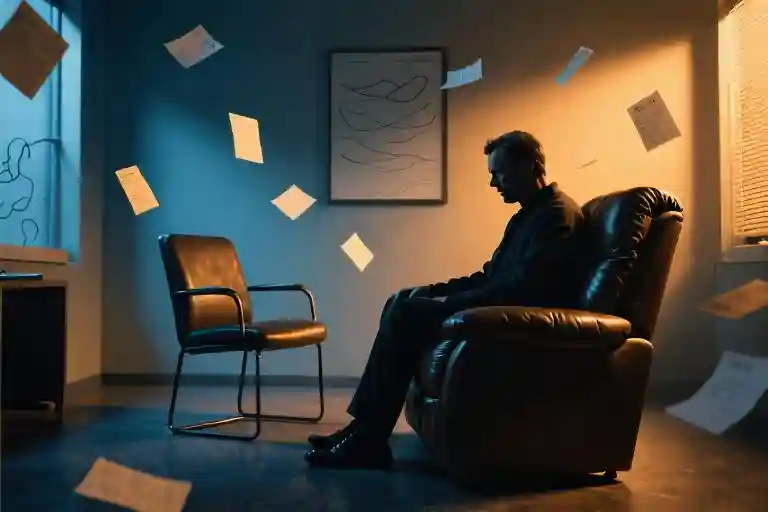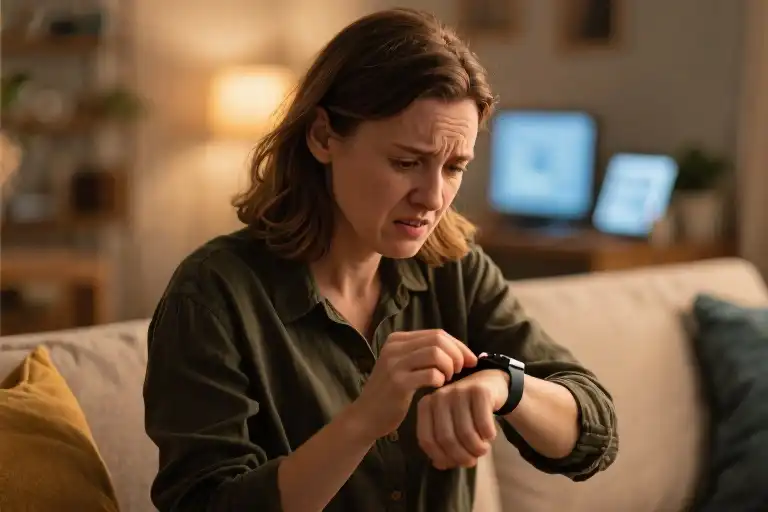This isn’t a story about bad therapy – but since you’re here, let me show you something worse. The scene unfolds in slow motion: first the subtle flutter of eyelashes losing their battle against gravity, then the gradual surrender of facial muscles as his chin begins its free fall toward the chest. Just when you think he’s gone, that cervical spine snaps to attention like a faulty car windshield wiper, jerking his head back upright with audible cartilage protest. The cycle repeats – droop, catch, repeat – creating a grotesque metronome measuring out the minutes of your paid agony.
What makes this particular brand of professional failure so devastating isn’t the obvious breach of ethics. It’s the physiological poetry of it all – how your raw confession about childhood trauma becomes his biological lullaby, how your voice transforms into some sort of vocal Ambien. The content could be anything – describing sleep paralysis demons or your grandmother’s funeral – his nervous system responds identically: pupils dilating to blackout curtains, breath slowing to meditative rhythm. You realize with horror that you’ve become a human white noise machine.
There’s an art to this particular professional failure. Lesser therapists might fully succumb, their snores creating awkward duet with your trauma narrative. The true master maintains that exquisite edge of consciousness, riding the wave of microsleeps with the precision of a surfer who’s forgotten why he’s on the board. His note-taking hand continues moving – the cursive degrading into seismograph spikes – while some primitive part of his brain keeps the social contract technically unbroken. The session will end precisely at 50 minutes, the check will be cashed, and you’ll leave wondering if you imagined the whole thing.
What we’re witnessing here is the perfect storm of bad therapy – where professional detachment mutates into clinical dissociation, where the therapist’s chair becomes a recliner, where your insurance dollars buy you a front-row seat to someone else’s nap. The tragedy isn’t that he’s tired (therapists are human), but that his exhaustion becomes the loudest presence in the room, drowning out whatever fragile truth you hauled in that day.
And here’s the cruel joke: this isn’t even the worst-case scenario. At least sleeping therapists announce their failure with biological honesty. Far more dangerous are the wide-awake professionals who’ve mastered the art of therapeutic pantomime – the strategic nodding, the well-timed “mm-hmms,” the notebook filled with grocery lists disguised as process notes. They’ll reflect your feelings with dictionary precision while mentally planning their dinner, performing empathy like concert pianists sight-reading sheet music.
This is how the system fails us twice over – first through obvious negligence, then through convincing simulations of care. The dozing therapist at least lets you know where you stand (or rather, where he lies). The truly dangerous ones teach you to distrust your own perception, to swallow the suspicion that something’s missing, to mistake professional ritual for human connection. They turn the therapy room into an echo chamber where your pain hits the walls and comes back polished into something more palatable, more manageable, less yours.
Professional Anesthesia
There’s a particular kind of irony when the person paid to stay present with your pain becomes physically incapable of staying awake. The therapist’s office transforms into a bizarre sleep laboratory where your trauma narratives double as lullabies. I watched it happen in real time – the slow surrender of facial muscles, the gravitational pull on his forehead, the valiant but doomed resistance of his neck tendons. Each sentence I uttered seemed to deposit another sandbag on his eyelids.
Neuroscience explains this phenomenon better than any therapy manual ever could. The human voice carries frequencies that can stimulate alpha brain waves, those gentle ripples associated with relaxed alertness. But when professional detachment meets emotional exhaustion, those same frequencies become a sedative cocktail. My therapist’s brain had apparently classified my suffering as non-essential background noise, the psychic equivalent of elevator music.
The biomechanics of this professional failing deserve documentation. Observe the eyelid’s flutter phase – rapid contractions of the orbicularis oculi fighting against descending relaxation. Then comes the head drop, a sudden release of the sternocleidomastoid’s tension, arrested midway by a spinal reflex so sharp it should have warranted whiplash compensation. The most tragic element? This cycle repeated with metronomic precision every ninety seconds, syncing perfectly with the rhythm of my childhood trauma revelations.
We measure therapeutic effectiveness in countless ways, but perhaps we’ve overlooked the most telling metric: the number of times your therapist’s chin hits their chest during session. Mine was averaging twelve episodes per fifty-minute hour, an impressive failure rate by any standard. The content of my stories ranged from mildly disturbing to clinically severe, yet his physiological responses remained remarkably consistent – slight nostril flare at graphic details, suppressed yawn during emotional climaxes, full chin-to-collarbone contact during pivotal revelations.
What makes this dynamic particularly cruel is the inherent power imbalance. The client monitors every microexpression for signs of understanding, while the professional battles basic biology. I found myself unconsciously modulating my trauma narratives – emphasizing certain words, inserting dramatic pauses – not for therapeutic value but as a desperate attempt to maintain his wakefulness. The therapy session became a perverse comedy routine where the punchlines were my painful memories and the laugh track was his soft snoring.
Animal behavior studies show that mammals instinctively mirror each other’s alertness levels. Watch any dog park – when one canine lies down, others soon follow. This neural mirroring explains why his drowsiness became contagious. By session’s end, we’d achieved a tragic synchrony – his head bobbing to stay awake, mine nodding in defeated recognition that this expensive nap time would appear in my medical records as ‘psychodynamic processing.
The Daisy Trauma Experiment
The most dangerous therapists aren’t the obviously incompetent ones – they’re the technically proficient professionals whose responses have become as conditioned as a dog’s tail wag. I discovered this when testing how Daisy, my neighbor’s golden retriever, would react to violent poetry delivered in a baby-talk voice.
Professional detachment in therapy operates on similar principles. A therapist’s nodding rhythm often mirrors that canine tail – metronomic, predictable, and completely divorced from the actual content. The head bobs continue whether you’re describing workplace stress or childhood sexual abuse, just as Daisy kept thumping her tail against the floor while I whispered horrors about sausage grinders and cauterized wounds.
This phenomenon explains why so many therapy sessions feel simultaneously comforting and empty. The professional framework – the soft tones, the periodic ‘mm-hmm’ sounds, the strategic pauses – functions like emotional muzak. It creates the ambiance of being heard while often missing the actual message. The violent dog poem experiment proves that mammals primarily respond to emotional frequencies rather than lexical content. We’re all just slightly more sophisticated Daisy’s when it comes to therapeutic communication.
Three unmistakable signs reveal when a therapist has slipped into conditioned response mode:
- The Tilt-Free Nod: Genuine engagement causes slight head tilts (approximately 11-15 degrees according to nonverbal research). Mechanical vertical nodding indicates autopilot.
- The Clipboard Paradox: Note-taking rhythms that don’t correspond to emotional beats in your narrative suggest they’re transcribing rather than processing.
- The Delayed Blink: Natural listeners blink during speaker pauses. Therapists blinking while you’re mid-sentence may signal disengagement.
The scary truth? Many professionals don’t realize they’ve developed these patterns. Like my sleep-fighting therapist, they believe they’re fully present while their body betrays them. The industry’s emphasis on ‘technique’ over authentic presence creates practitioners who can perform therapy without actually doing it.
Daisy eventually walked away from my poetic experiment when the cognitive dissonance became too great. Patients rarely have that luxury – we keep talking to the nodding heads, mistaking professional rituals for human connection. Perhaps we’re all just waiting for one authentic flinch, one unscripted reaction that proves there’s actually someone home behind those professionally trained eyes.
The Anatomy of Presence
Real listening has a physiology all its own. You’ll know a therapist is truly present not by their diplomas or carefully curated book selection, but by the unconscious choreography of their body. These are the biological tells no acting class can replicate:
The Pupil Pulse
Watch for the subtle dilation-contraction cycle mirroring your emotional intensity. Pharmaceutical reps can fake attentive nodding, but autonomic nervous responses don’t lie. When discussing trauma, authentic engagement shows in 0.5mm pupil expansions every 3-4 seconds – the neurological signature of someone mapping your experience onto their own neural pathways.
The Penmanship Paradox
Therapeutic note-taking should resemble an EKG readout rather than meeting minutes. Look for sudden ink smudges when your voice cracks, sentences trailing off mid-word as their hand freezes to absorb your pause. Beware the clipboard warrior whose pen moves in metronomic indifference, producing neat blocks of text untouched by your emotional cadence.
The Gravity Defiance
Authentic therapists fight Newton’s laws. Their spine will lean forward imperceptibly as you speak, center of gravity shifting toward you like plants toward sunlight. The chair’s front legs may actually lift slightly during pivotal moments – a full-body rebuttal to the gravitational pull of professional detachment.
These micro-behaviors expose the dirty secret of mental health care: the system actively suppresses them. Insurance reimbursement demands robotic DSM-code recitation. Productivity metrics turn sessions into emotional speed dating. One veteran clinician described modern practice as “performing CPR while being timed on a spreadsheet.”
We’ve medicalized presence until it resembles those nature documentaries where zookeepers use puppets to feed orphaned chicks – all the right motions, none of the warmth. The tragedy isn’t just bad therapists falling asleep; it’s good therapists being trained to simulate wakefulness.
Somewhere between the diagnostic checklists and productivity requirements, we forgot a simple truth: healing begins when someone’s nervous system says “I’m here” before their mouth opens. That message transmits through channels no licensing board can measure – in the hitch of a diaphragm when your pain resonates, the way their shoes scuff the floor as they instinctively bridge the distance between your suffering and their care.
The Unfinished Lullaby
The poem ends mid-sentence, the way bad therapy sessions often do – with important things left unsaid, hanging in the air like the therapist’s head that never quite completes its descent. That permanent 0.5-second gap between consciousness and surrender becomes the perfect metaphor for professional relationships that exist in perpetual limbo, never fully present yet never officially absent.
Notice how the violence in those dog-directed verses mirrors the quiet brutality of therapeutic neglect. When professionals weaponize their training against basic human connection, the damage becomes structural. Those carefully constructed neutral faces and measured tones can inflict deeper wounds than any shouted obscenity – precisely because they come wrapped in the legitimacy of clinical detachment.
Consider the therapist’s unfinished nod, forever caught between professional duty and human exhaustion. That suspended moment contains all the contradictions of modern mental health care – the tension between billing hours and healing souls, between evidence-based practice and evidence of actual practice. The head that refuses to fall becomes the profession’s entire predicament made visible: too tired to care properly, too professional to admit it.
And the poem? Its abrupt termination leaves readers with the same hollow sensation as patients who’ve experienced therapeutic abandonment. That missing final line echoes the missing closure in countless treatment relationships where the real work never happened, where practitioners and clients simply went through motions until insurance ran out or calendars filled.
The therapy room fades to black on this frozen image – the drooping head, the unfinished verse – leaving us to wonder which is worse: the professional who sleeps openly, or those who remain technically awake while their attention drifts elsewhere? At least the sleeping therapist gives us the honesty of his exhaustion. The others make us doubt our own perceptions, wondering if their glassy-eyed attention is really focus or just superior eyelid control.
Perhaps this is why we return to that suspended moment, the head neither fully up nor completely down. It’s the perfect snapshot of contemporary therapy’s purgatory – not bad enough to condemn, not good enough to heal, forever trapped between what it claims to be and what it actually delivers. The poem’s missing ending becomes our missing resolution, the treatment that never quite arrived, the professional who never fully showed up.
In the end, we’re left with two incomplete things: a cruel lullaby without its final words, and a helping profession that keeps forgetting how to finish its most important sentences.





